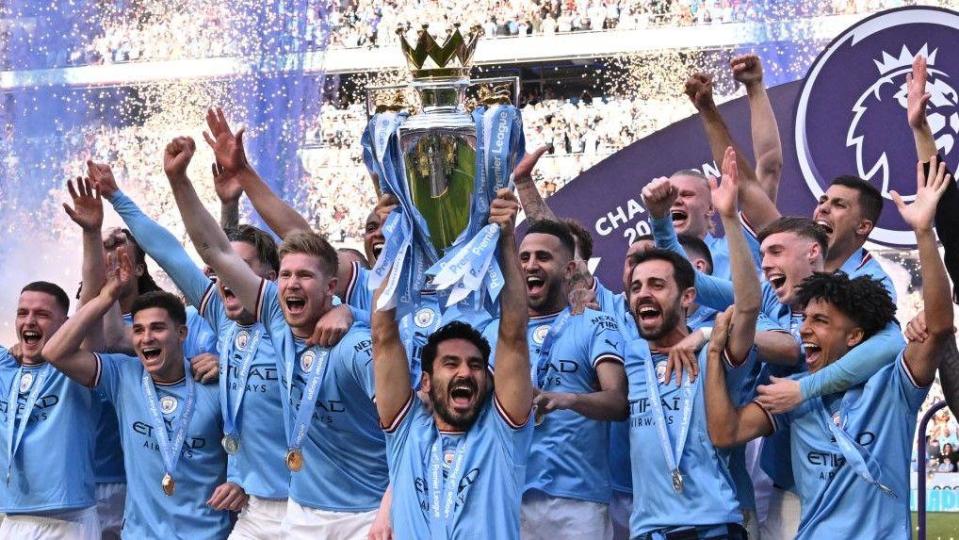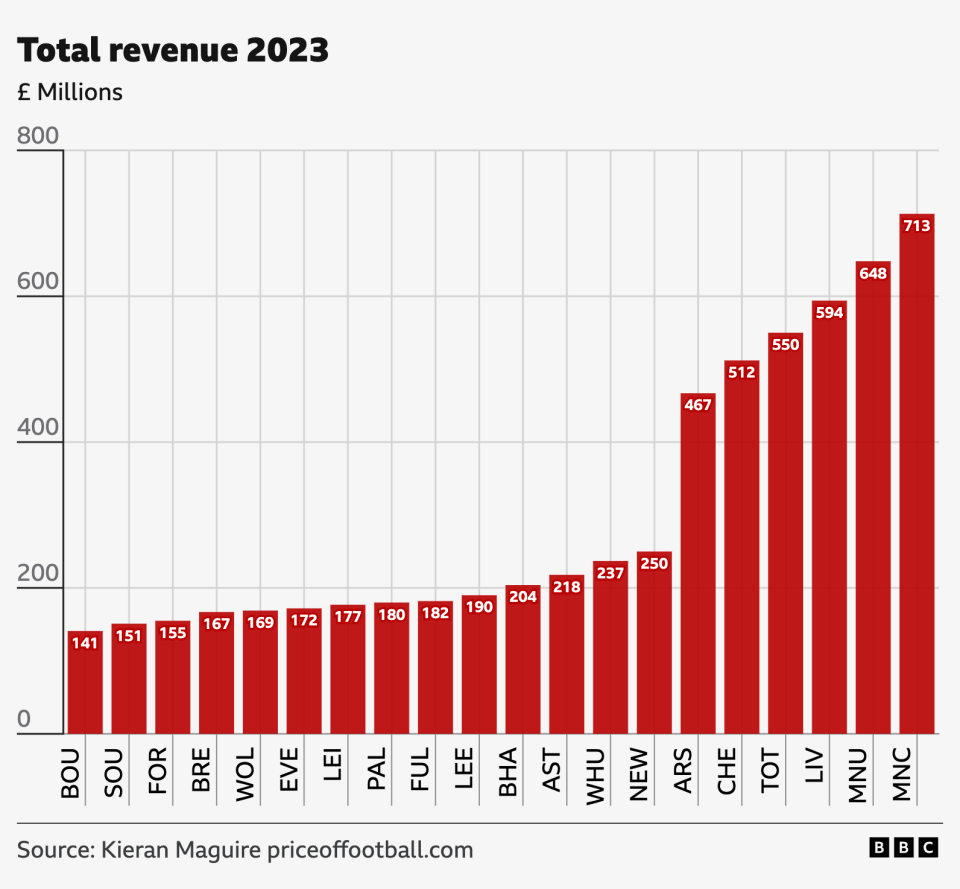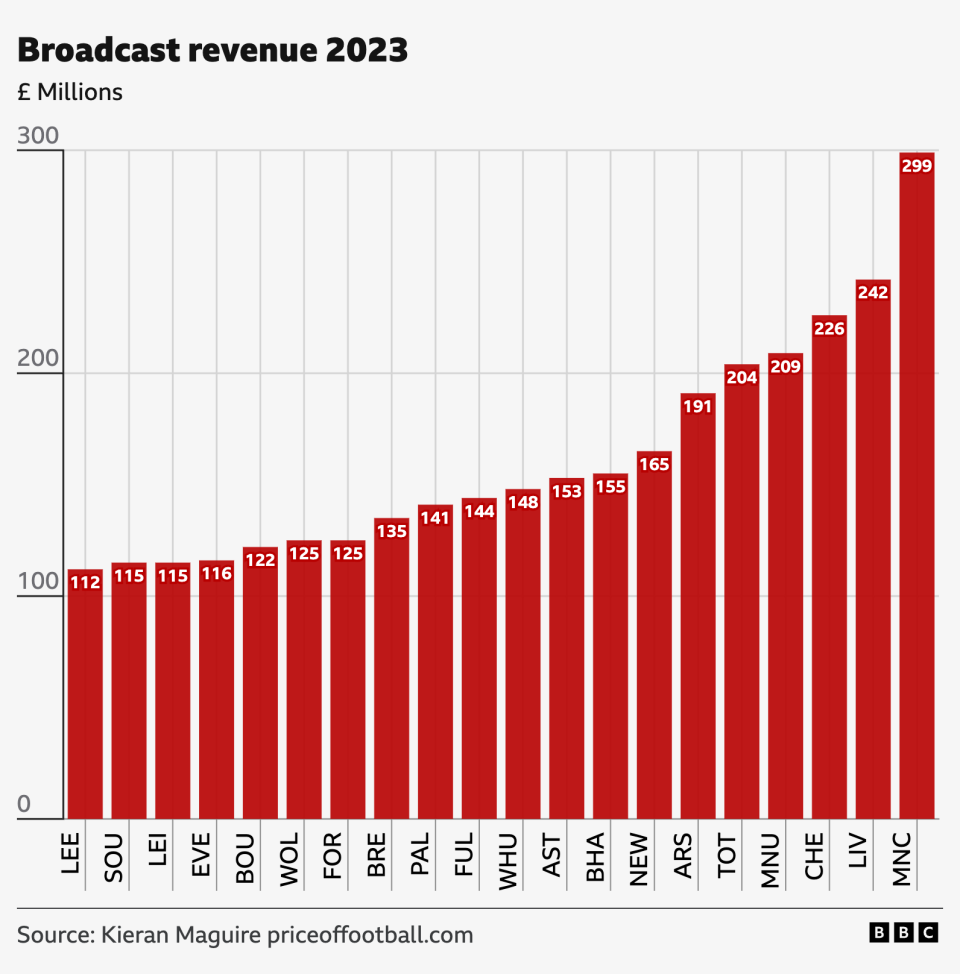Premier League clubs back plan to look at spending cap

Premier League clubs have voted in favour of developing plans to introduce a spending cap.
Sixteen clubs approved proposals for the Premier League to complete the final economic and legal analysis needed to create a spending-cap model.
The model might be presented to clubs at June's annual general meeting (AGM), and if voted through it would replace the current Profit and Sustainability Rules (PSR) from the 2025-26 season onwards.
Manchester City, Manchester United and Aston Villa opposed the possible introduction of a spending cap on Monday, while Chelsea abstained.
The league's current financial rules, under which Everton and Nottingham Forest were penalised eight and four points respectively this season, have been criticised for favouring clubs with the highest revenues.
A spending cap would limit clubs' outlay on transfers, wages and agents' fees.
Proposals have reportedly included spending being capped to between four and five times the amount the lowest-earning Premier League club receives in TV revenue.
Leeds United, who finished 19th in the Premier League in the 2022-23 season, earned £112m in broadcast revenue - the least out of the 20 clubs in the top flight.
What are the current rules?
The Premier League's Profit and Sustainability Rules permit clubs to lose £105m over a three-season period.
The Premier League says the current regulations are designed to try to ensure the long-term financial sustainability of clubs and maintain the competitive nature of the league by preventing "unfair advantages".
What is the background?
In February, the Premier League was warned that a failure to reach a funding deal with the English Football League (EFL) would mean an agreement being imposed on it by a new football regulator being created by the government.
The following month, the Premier League and the EFL failed to settle on a funding deal.
Instead, the Premier League said that the clubs in the top flight had agreed to introduce a new, competition-wide financial system to replace the Profit and Sustainability Rules.
What is Uefa's Financial Fair Play model?
When the idea of moving away from the Profit and Sustainability Rules was first discussed, it had been anticipated that Premier League clubs would move towards a model adopted by Uefa.
Under Uefa rules, clubs can spend no more than 90% of their revenue on squad costs. This will reduce to 70% from the 2025-26 season.
This means the amount they can splash out is limited by the amount of cash they generate.
Why do some clubs oppose the plans?
Some clubs oppose the idea of a spending cap because they feel it threatens to penalise clubs with large revenues, which - they argue - have been built by sporting achievement and commercial innovation.
Others say that levelling out competition in the Premier League threatens to undermine the global standing of the league itself, as it could put English top-flight clubs at a disadvantage against their European counterparts.

What happens next?
The Premier League will now develop a spending-cap model.
The vote on Monday only concerned the development of a model, not the introduction of one.
Premier League clubs will meet again at June's AGM, when they might be presented with the Premier League's analysis and model.
Discussions will then take place on the model, before a possible vote.
What could a spending cap look like?
Football finance expert Adam Davis believes that the proposed spending cap would allow clubs like Newcastle and Nottingham Forest to spend the amount they feel they need to in order to be competitive, but could also push some teams to financial breaking point.
“We don’t know the ins and outs of what the spend cap will include but our understanding is that the amount that is allowed to be spent is likely to be on player wages, amortisation and agent fees,” said Davis.
“That will be a fixed total based on the lowest amount of broadcasting money received in the Premier League, so whatever is earned by the 20th club. Over the last few years that has basically meant approximately £100m-worth of broadcasting income, that is what the likes of Sheffield United will earn.
“The spend cap will be a hard multiple, and the rumoured amount is five times that amount, which would basically mean a spend cap of approximately £500m.
“From a good perspective, that will open up the likes of Aston Villa and Newcastle to spend more than what they currently have because under the current regulations it is tied to their own revenues.
“It would also mean under a new regulation, teams like Nottingham Forest could spend what they want to spend, or claim they need to spend, to stay competitive.
“A potential negative is that spending will increase in the Premier League to potentially unsustainable levels.
"The danger is that by saying you are able to spend more, it could be interpreted as you must spend more to remain competitive. We could potentially see more and more clubs pushing to breaking point.”
How much do Premier League clubs make in TV revenue?


